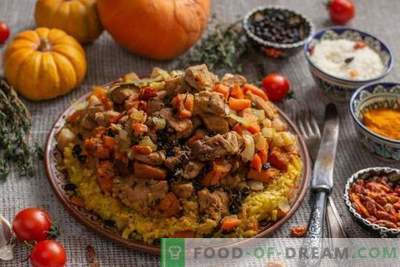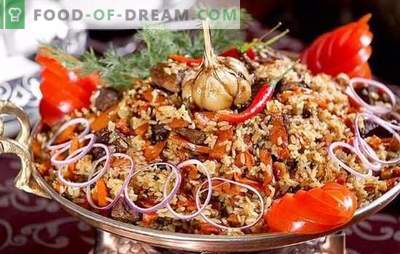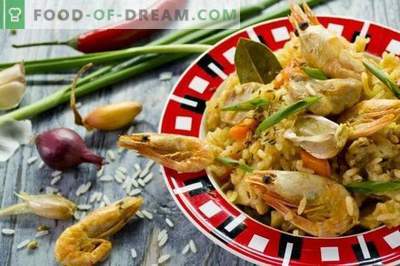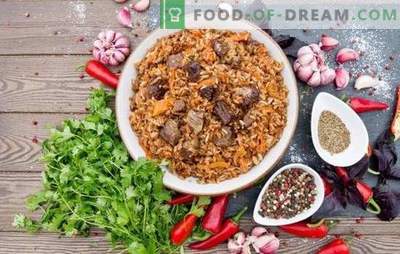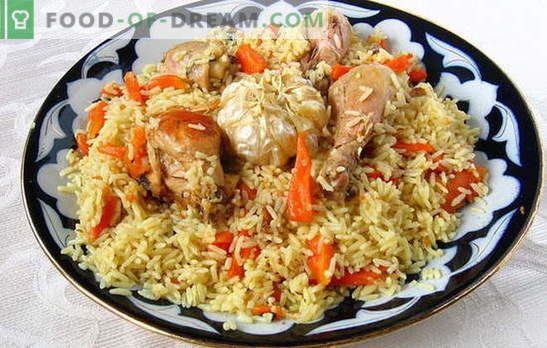
Which ingredient plays a leading role in the swim?
If someone thinks it is meat, then this is a delusion.
There are recipes for pilaf (and there are a lot of them!), Which contain no meat.
In some cuisines of the world there are quite traditional recipes of pilaf with fish, vegetables or fruits.
In addition to spices, there is one more component for any kind of pilaf - rice.
True, this type of cereal is often found in recipes in combination with other cereals and even with leguminous vegetables, but, nevertheless, rice is considered to be the main ingredient of pilaf in world culinary.
Rice is one of the oldest and most important grain crops on the planet, so it is not surprising that its varietal diversity has reached its peak, including with the participation of breeders. From this it follows that by growing rice for thousands of years and constantly improving its qualitative characteristics, humanity sought to achieve certain of its properties that would meet the same specific criteria for its culinary processing.
Particular attention is paid to the cultivation of rice in Asian countries, where this is more consistent with climatic conditions. We will not list the countries that grow them and rice varieties, as the lists will be very long, and it will be difficult to remember all the information at once. If desired, all the famous names of rice varieties and their main characteristics can be found in the open spaces of the “world wide web”. It is important to understand and remember that pilaf crumbiness, as well as its taste, depend on the variety of rice selected.
How to make crumbly pilaf - basic technological principles
Considering that a dish where rice is present and one of the listed components (meat, fish, vegetables, fruit) can be called a pilaf would also be a mistake. But it must be borne in mind that the technology of cooking plov is not limited to the only method that is most known and popular in the territory of the CIS countries, which is remembered by many recipes for making Uzbek pilaf. By the way, because of its popularity, the Uzbek plov also acquired many additional options, both from the point of view of the preparation technology itself, and of its ingredients. Every culinary specialist who at least once tried to reproduce in his kitchen, somewhere in Ukraine, in the Baltic States or in Kamchatka, for lack of the right type of meat or set of spices, rice varieties, and, finally, the “right” cauldron, which traditionally is cooked Fergana plov in Uzbekistan, made its amendments to the recipe. There were recipes for pilaf from pork and Krasnodar rice, from shrimps and basmanti rice and many other experimental recipes. This is not to say that these recipes were unsuccessful. Subject to certain technological conditions of cooking pilaf, they have the full right to exist. It should also be noted that the very concept of “Uzbek pilaf” is very vague, because, like any popularly respected dish, it is prepared in each city and village of Uzbekistan in its own way.
What should be pilaf? This dish has its own history, which lasts in time along with the most ancient civilizations of the planet, therefore it would be wrong to assert that only the residents of Fergana or Samarkand, the people of Turkey or India are right.
Each national cuisine has its own cooking characteristics, but all of them are aimed at achieving a single result that is uniform for all types of pilaf: rice - the main component of the dish should be crumbly. This is the common and characteristic feature that distinguishes pilaf from rice porridge, with meat or with something else.
So let's summarize. The first condition for the preparation of crumbly pilaf is the rice variety, its properties, or rather, the hardness of the grain and its starch content. The second condition is rice cooking technology.
To fulfill the first condition, it is necessary, at a minimum, to know the assortment of rice, its biochemical composition, and in which pilaf recipe one or another type of grain is used in traditional cuisine. This issue in one small article is extremely difficult to highlight. But, as for the fulfillment of the second condition, some practical methods of preparing crumbly rice can be mastered in the home kitchen.
Each housewife noticed that if you throw a spoonful of starch in cold water, the powder is knitted into solid lumps. Similarly, the starch contained in rice is also rolled. That is why rice is soaked before cooking. Under the stream of water, while washing the rice, the water becomes turbid. It is starch, and it sticks together rice, turning pilaf into a viscous porridge. After a long stay of the grain in the water, it becomes hard, and no longer becomes viscous during cooking. On the Internet you can find expert tips that suggest soaking rice at 60ºC. What is there to say? If there is additional time for laboratory experiments to monitor the maintenance of such a temperature, a thermometer, then in order to gain additional experience, try this method, and at the same time present the ancient Persian, who had neither the Internet, nor a thermometer, but The recipe for pilaf from Avicenna, meanwhile, has been preserved to this day. Of course, how to manage your time is a personal matter for everyone, but it’s still much simpler to take rice in ordinary, cold water for at least two hours and not sit over it with a thermometer, like a sick child.
Quenching rice in fat additionally covers the grain of the shell that keeps moisture inside: they reach softening and degree of readiness by steaming the moisture soaked when soaked under the oily film, increasing in size, and the same film additionally prevents the rice grain from sticking to each other.
The word “pilaf” goes back to Sanskrit and its literal meaning is boiled rice. But, to put it in modern language, the technology of cooking pilaf is more of a quenching, since the cooking process is considered to be heat treatment at the boiling point of water, and all known pilaf recipes indicate slow heat treatment of rice below 100ºC. By the way, at the boiling point of water, starch will begin to separate from the rice grains, which will surely turn pilaf into ordinary porridge.
But nevertheless, there are plov cooking technologies in which rice is pre-boiled until half ready and such techniques cannot be rejected, since they appeared thousands of years ago, long before the recognition of cooking as a science, and they are much older than the Uzbek cuisine. Such methods of cooking pilau are still used, for example, by modern Indian women who carefully preserve the traditions of one of the most ancient Asian cultures. Separate cooking of meat and cereal parts of pilaf is also peculiar to Azerbaijani, Turkish, Iranian and Arabian cuisine. It seems that pilaf is, nevertheless, boiled rice, as it was originally called. In order not to waste time and combine the study of the theory with the more interesting practical part, consider the different cooking techniques of crumbly pilaf using the examples of traditional recipes of some national cuisines.
1. How to make crumbly pilaf: “Biryani” with chicken or pilaf in Indian style
A mixture of spices for pilaf can be purchased in specialized stores, as well as ghee. For Indian pilaf, whole chicken meat is used, but in some provinces of India only chicken breast is consumed. The quantity and the ratio of the necessary ingredients is indicated in accordance with the original recipe, but, taking into account the particular Indian passion for spices, make an amendment at your discretion.
Ingredients:
Chicken 0.5 kg
Basmanti - 500 g
“Ghee” (melted butter) 400 g
Onions, chopped 450 g
Tomatoes 0.4 kg
Ginger root 50 g
Natural yoghurt (without sugar) 150 ml
Garlic 40g
Celery Leaves, Chopped 70 g
Turmeric 2-3 g
Mint leaves, cut 50 g
Salt
Biryaani Masala (a mixture of spices for pilaf) 45 g
Preparation:
Heat the oil in a cast-iron, deep frying pan or in a skillet, and fry in it a very finely chopped onion until golden brown, adding a little salt. Collect the fried onions with a skimmer and place for a while in a separate dish. Place prepared chicken meat in a saucepan. Fry one side over high heat, and then turn it over, lowering the heat, stewing the meat over low heat until it starts to separate from the bone. Cover the pan with a lid. If necessary, add a little water to extinguish, but at the end of quenching the liquid in the skillet should not remain.
Remove bones from chicken, put pulp in a saucepan, add chopped tomatoes (without peel), chopped ginger and garlic, spices
Pour at least 3 liters of water into the pan, salt it and boil the washed rice, dipping it directly into cold water, until half cooked and, drain the water, spread it on a wide dish to cool it. In a clean saucepan, fold the prepared onions, rice and stewed chicken meat in layers: half chicken flesh; half rice; half fried onions; chopped celery; mint. Now repeat laying layers, starting with the rest of the meat. Spice up each layer with spices.
Put the pan on a low fire and heat the “Biryaani” for 10-15 minutes.
2. How to make crumbly pilaf: Fergana or Uzbek pilaf
Many dishes of Uzbek cuisine are a shock for modern dietetics. In particular, pilaf is prepared using a large amount of animal fat, which contributes to obtaining more crumbly rice, but adversely affects digestion. The only way out of the current contradiction is the fruit dessert. Moreover, in the dessert it is necessary to include fruits or berries with a high content of vitamin C, contributing to the breakdown of fats: pomegranate, barberry, pineapple, cranberry. A good addition to fatty pilaf will be a salad with a lot of parsley. What vegetable oil to use? Cotton oil is used in the homeland of the Fergana pilaf, but even there it is considered far from perfect, so replace it with a more neutral taste or choose a nutty flavor that goes very well with rice.
Ingredients:
Onion 170g
Devzira rice, unpeeled (red) 300 g
Carrots, yellow 350 g
Cumin (grains)
Barberry
Dill (seeds)
Coriander
Sesame, ground
Rayhon (basil)
Garlic 2 whole heads
Fat lamb 0,5 kg
Vegetable oil 100 ml
Cilantro grains
Saffron
Cooking:
Rinse the rice thoroughly using cold running water and fill it with at least two hours of cold water. Cut the onion into large rings, juicy and ripe carrots - kupannye sticks. Cut lamb with layers of fat into medium sized cubes. Prepare the garlic in advance by peeling off the upper scales, cutting the roots so that the white slices of the slices are visible from below.
If you do not like the presence of whole grains of spices in a dish, then grind them in advance. Barberry is better to add fresh, but due to the complexity of the acquisition, use dried berries. Start preparing the dishes. Thick-walled, preferably cast-iron stew-pan, put it on medium heat and heat it up before pouring in the oil that needs to be reheated so that it starts to smoke slightly. Throw the onion into this butter and do not stop stirring until the onion turns brown and immediately send the prepared meat to the boiling fat, which must be brought to semi-ready, add carrot sticks, salt and cooked spices to it, switch the fire further state of languor. Try zirvak - it should be salty and tangy, taking into account the further addition of rice and water.
Pour the prepared rice and cover with 3-4 cm of boiling water on top. In the center of the saucepan, make a well in the rice so that the steam comes out through this hole. More pilaf can not be mixed. If before that everything was done correctly, then it will not burn. Put garlic on top of rice, spreading the heads evenly over the surface, sprinkle the pilaf with barberry and simmer. Cover the saucepan with the lid and turn off the stove when the water is not completely evaporated. In this state, the pilaf must be kept for at least thirty minutes. When serving, the pilaf is not mixed, but turned over, after removing the garlic heads, and then shifting them to the center of the dish.
3. How to make crumbly pilaf: Arabic pilaf with vegetables
Each dish has its own name, depending on the constituent ingredients and the method of preparation: “couscous”, “matluba” and this list of transliterated words can be continued by the number of Arab countries and the variety of ingredients. Arabic pilaf differs from Indian in a smaller assortment and quantity of spices used.
Arabic pilaf is the common name for an assortment of rice dishes, traditional for Arab countries, where there is also, as in Asian cuisine, pilaf made from lamb, beef, poultry and fish. The cereal portion of the Arabic pilaf may be rice in combination with other types of cereals, nuts, dried fruits, and vegetables. The technology of cooking pilaf consists in the separate preparation of rice, which is boiled or fried, and the meat part of the dish, which is also fried, boiled or stewed with vegetables, then combined with rice and other types of cereals when serving the dish. Ingredients:
2.2 kg chicken
Onions 500g
Black pepper 10 g
Carrots 400 g
Refined oil (for frying chicken)
Tomatoes 300 g
Saffron
Tomato sauce (spicy) 50 g
600 g rice
Peas, green (or corn) 350 g
Ghee 180 g
Caraway
Cinnamon
Dried coriander
Garlic 30-40 g
Cooking:
Wash the tarred and gutted carcass and put it in a saucepan, cook, pour in cold water. Remove the foam that has risen to the transparency of the broth, then add a small onion, roots, bay leaf. When the chicken is ready, separate the meat from the bone and chop the flesh.
Wet the rice (it is better to do it at night) Or use steamed rice, wet it 2 hours before cooking. Wash and boil in salted water. Throw through a colander or strainer, rinse with cold water. Heat the oil in a skillet, pour the saffron boiled in a small amount of boiling water into it and put the rice. Heat the rice in the oil, mixing well, so that the rice is colored to a uniform color.
Heat the vegetable oil, put chopped garlic, ground seeds of cumin and coriander, cinnamon stick, pepper in a frying pan. Fry the chicken pieces until golden brown and temporarily place them on the dish. In the process of frying, before the end, add the butter, for taste.
Finely chopped onions and carrots, pass in melted butter (50-60 g), also adding salt and spices, slices of tomatoes, pre-blanched and peeled, spicy tomato sauce. Put the fried chicken meat in the cooked vegetables and stew, letting the sauce boil and remove from the stove.
Put the melted butter (70-80 g) in a clean dish and heat it. Fresh green peas are pre-boiled in marinade, adding salt, sugar and lemon juice, and frozen - fry in oil immediately (without defrosting), before removing moisture. If you want to add corn, you can use canned, or pieces of fresh, sweet corn, milky ripeness. Combine the cooked portions of the pilaf, laying them out in layers. Rice - at the bottom, on top - peas and corn, meat can be served separately or put on top of the dish.
4. How to make crumbly pilaf: “balykly yanakhly-ash” - Turkmen fish pilaf
In Turkmenistan, too, pilaf is cooked on weekdays and on holidays. Festive pilaf - from camel meat, lamb, beef and pheasants or ordinary chicken - on weekdays. The difference between meat pilaf - a minimum of spices. Actually, besides salt, other flavorings are rarely used. In the Caspian areas often cook pilaf with fish. This is a very unusual and tasty combination. Of course, the fish should be chosen correctly: it should be fat, from “noble”, at least - pike perch, catfish, but better - sturgeon species.
Ingredients:
Pike perch fillet 1 kg
Sesame oil 250 g
Rice (steamed) 0.5 kg
Sour cream 300 g
Onions 400g
Carrots 350 g
Pomegranate juice 300 ml
Black pepper (ground and peas)
Fennel seeds
Bay leaf
Saffron
50 g root and green parsley
Salt
Dill leaves
Cooking:
Prepared fish fillets are cut into large pieces and dipped in boiling water, add a small portion of onion, bay leaf, chopped parsley root and boil until half cooked. We take out the fish and shift it to the saucepan, filter the broth. Season the fish with spices, a portion of saffron, salt, cover with sour cream and simmer until tender.
Wash rice and pour boiling water for half an hour. Pour sesame oil into the cast-iron dishes and heat it. Throw the chopped onion, fry, add the carrots, cut into large straws. When the carrot is soft, pour the fish broth into the dishes, let it boil and throw the rice that has been drained and washed in cold water, simmer in moderate mode until ready, seasoned with salt, saffron, the second part of spices and spicy greens.
Put the rice in a deep dish, pour with pomegranate juice and serve fish to it in sour cream.
5. How to make crumbly pilaf: Greek pilaf
The ancient shores of Hellas gave the world many wonderful discoveries, but Greece was never the birthplace of pilaf. But the ancient Greeks - famous shipbuilders and travelers. Historians and archaeologists still find traces of the world's oldest navigators in the most seemingly unexpected, given the modern technical capabilities, places. Rice in Greece is also not a traditional agricultural crop, but Greece knows how to surprise, and Greek pilaf in this sense is no exception. Actually, the technology of cooking rice in Greek cuisine is no different from its preparation in Arab countries. The only noticeable difference is the traditional Greek herbs. In Greek cuisine, they are well acquainted with the varietal variety of rice, but preference is given to the only variety in the world that grows only at the foot of the Himalayas.
Ingredients:
“Basmanti” 400 g
Carrots 120g
Dates 70g
Leek 100 g
Thyme 30g
Oregano 10 g
Chicken drumstick 900 g
Olive oil 100 ml
Saffron 1 g
Lemons 200 g
Sour cream (or cream) 180 ml
Cooking:
Wash the meat, dry with a napkin and rub it with salt and pepper. Fry the legs in hot oil until a crisp crust appears. Separately, pass the onion, chopped into half rings, and coarsely grated carrots. Add the chopped dates to the vegetables, the fried drumsticks, and pour the broth over the whole. Season the stew with spices, boiled in boiled water with saffron, salt, pour in lemon juice and fresh zest of two lemons. Put rice in water in a saucepan. If necessary, add hot broth so that the rice is completely covered with it, cover the pan with a lid and stew until the moisture evaporates and the rice becomes soft. Pour in the cream, tuck in chopped greens, wrap the pan tightly with a thick towel and let stand for some time.
6. How to make crumbly pilaf: Azerbaijani pilaf - “sezi govurma” with chestnuts
Ingredients:
Rice “basmanti” (or long-grain, steamed) 500 g
Veal 300 g
Turmeric 10 g
Lemon juice 25-30 ml
Dried plum (or prunes)
Chestnuts
Onions 200 g
Dried apricots 80-100 g
Melted butter
Raisin 50 g
Saffron
Pita (ready)
Cooking:
This type of pilaf is cooked in parts, and then everything is collected in a common dish.
Heat the ghee and fry the onion in thin rings, adding turmeric. Cut the veal into small pieces and boil it in salted water. For flavor add a small, whole onion. Remove the meat with a skimmer and transfer to a saucepan with onions, washed cherry plum (or prunes) and peeled chestnuts. Pour all the broth and stew until soft chestnuts, covered with a lid. Then remove the lid and let half of the water evaporate. Set aside govurma.
Wash the rice. Pour cold water into the pan so that it covers the rice, add salt and lemon juice. After an hour, drain the water and boil the grains in a large amount of boiling water until soft. Remove the water again. In 50 ml of boiling water, put the saffron, brew it and pour the infusion of rice, mix thoroughly.
Lavash smear with butter and lay on the bottom of a ceramic pan. Top with rice, cover the pan with a lid and bake for 1.5 hours at 150ºC.
Wash the dried fruits and steam them in a frying pan, add a little water, add 10-15 g of butter to the fruit when the water has evaporated. Remove from pan.
Collect the cooked pilau ingredients: put the rice on a large dish, around it - fruits and chestnuts, pieces of fried pita. Separately put the dish with govurma.
Plov is good because vegetarians can eat it without adding stew to their plate.
How to make crumbly pilaf - tips and tricks
Ate there was not in the presence of the desired varieties of rice to cook pilaf - do not be discouraged and do not rush to go shopping. To do this, any variety of steamed rice is suitable, and it can be steamed very simply: wash the rice and soak it in cold water. You can do this the night before and leave the rice in water in the refrigerator overnight. In the morning, drain the water that has not been absorbed and heat the dry cast-iron pan. Put the rice in it and just dry, constantly and gently stirring with a wooden spatula.
